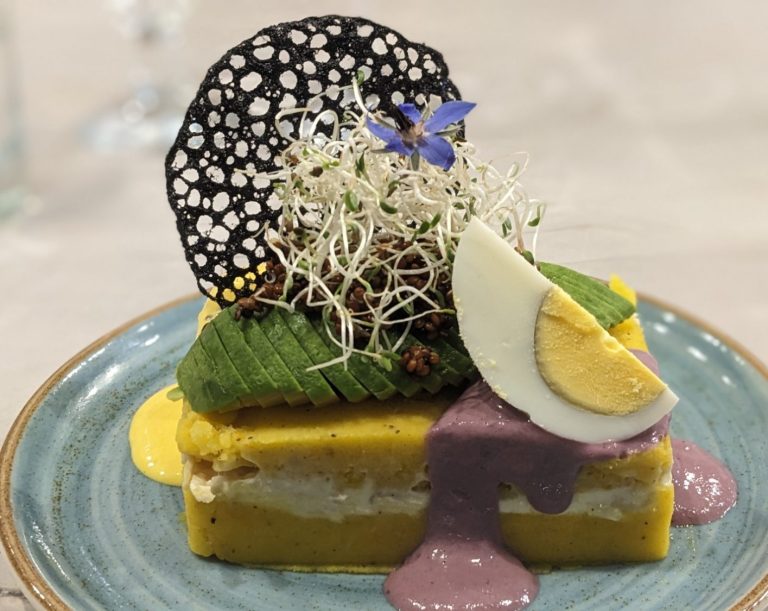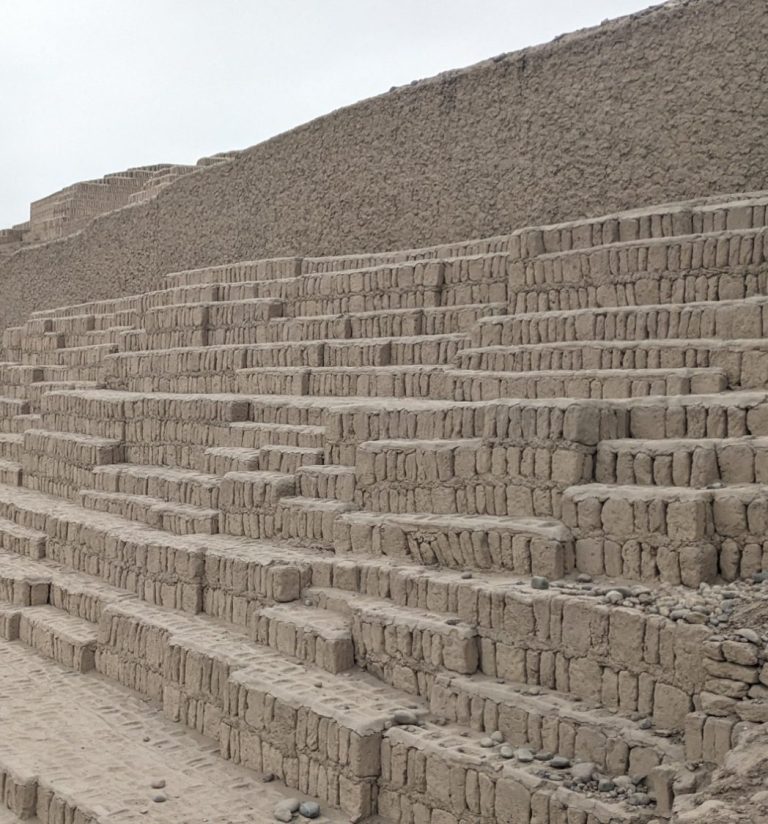Perú rico
***Deutsche Version***
It was already dark when we arrived at the Peruvian border. As we were queuing for our stamp, Dominik suddenly spotted a familiar face. A former fellow student was standing only a few metres away from us. It's just incredible how small the world is. We also met two people from our Spanish school in Sucre a little later. These chance encounters made all thoughts of crossing the border fade away and before we knew it, we were in Cusco on time (!). This was one of the few occasions we wished we had arrived late though. Unlike the Bolivian cities, Cusco was still very sleepy at 6 a.m., and the two 24-hour cafés we had researched in advance were closed. Yes, in South America, it is often not enough to have a plan A and B, but often you need plan C, D and E. That’s why until 8 a.m., we killed time at a square, bought a picture from a street vendor and got the most expensive shoeshine service of our lives. People know exactly which tourists they can rip off. But for the first time in months, we had really clean shoes. After all, one should always look on the bright side of life.

Our cooking class on the first evening was the perfect start to get to know the best of Peruvian cuisine. We prepared three different dishes and three cocktails. Afterwards, we were a little tipsy and glad that, unlike others in our group, we had scheduled a spare day before our big hike to Machu Picchu.

Salkantay Trek to Machu Picchu
We decided to earn the visit of the historic site of Machu Picchu with a wonderful multi-day hike. We were with a diverse and fun group for the next five days. After the fittest had overestimated their abilities on the first day and ran up the mountain or tackled it barefoot, things looked slightly different on the second day. The altitude took its toll on some of them, and they had quite a fight. The Salkantay Pass lies 4650 m above sea level, surrounded by spectacular white peaks. In the end, however, everyone made the climb to the top of the pass, and we performed a traditional indigenous ritual to honour what we had achieved. Meditating below the glaciated peak, accompanied by our guide’s flute sounds, was a thoroughly sensory-expanding experience.


From the highlands, the trail descended steadily into the Peruvian jungle. Embedded in the hilly landscape, we could already admire the imposing cities of Machu Picchu from a distance on the fourth day of hiking and had our destination in sight.
After a somewhat short night (Jana let her anger about a party directly below our room run wild and thus saved us a few hours of sleep), we already had to get up at 4 a.m., have breakfast and start walking. By this time, even the toughest guys in our group had run out of energy, and together with a German couple, we were the only ones who took the 1900 steps on foot. Shortly before sunrise, we reached the entrance and were allowed to enter the grounds first that day. Still without the crowds, the place was highly idyllic and peaceful. We marvelled at the sophisticated architecture of the Incas and what of it has been preserved for posterity. We took plenty of time to look at everything, climbed up a small mountain to get a different perspective, and descended the steps back down to Aguas Calientes.
After a long journey by train and bus, we arrived back in Cusco late in the evening and eagerly looked forward to a comfortable bed. After recovering from the long hike, we met up with some of the group for dinner and partying the next day. In contrast to Bolivia, we didn’t have to worry about ending up under a building, and partied boisterously until deep into the night.

Foodies on Tour in Lima
Our next stop was Lima. We planned to visit some museums in the Peruvian capital, marvel at the architecture and learn about its history. But something threw a spanner in the works—the delicious food. Our foodie hearts blossomed, and we spent most of our time at food stalls, markets, restaurants and cafés. We were really into Peruvian cuisine and took every opportunity to try something new.
The city has everything from expensive haute cuisine restaurants to tasty street food. We even went to the best restaurant in the world in 2023, Central, or rather, we had a glance inside. The 14-course menu can only be enjoyed with reservation months in advance, and it would also have been beyond our budget. Nevertheless, we dined in some of the best places in South America over those four days.

Besides all the food, we also saw some parts of the city on the way from one restaurant to the other. Lima is the second largest city after Cairo, with its 9 million inhabitants, which was built in a desert. Therefore, it surprised us that it still looked very green in some parts of the city. However, if you went outside the tourist zones, you immediately noticed that there is no money for irrigation. Since it hardly rains, some ruins from the 4th century have survived in the middle of the city. It is exciting that they were built before the Inca era and have a totally different construction style than Machu Picchu.

As there were protests announced in Lima, we left the capital again after four days to avoid political unrest. The situation in the country is tense. Many travellers we met decided not to visit Peru or to visit only certain parts of it. After the removal of the president in December 2022, there were violent protests all over the country. The vice-president, who took over the highest office of the state, is rejected by the indigenous and poorer people of the country because she embodies the hated capital establishment. With the protests, they want to force Castillo’s release and achieve new elections.
Once again at dizzying heights
We decided to go hiking again for a few days away from the big crowds in the beautiful area around Huaraz. Huaraz lies on the edge of the Cordillera Blanca, a protected mountain region in the tropical Andes with glaciated peaks. It is also home to Peru’s highest mountain, Huascaràn, at 6768 metres above sea level—a challenge we didn’t take.
The area also offers beautiful hikes with blue and green mountain lakes to admire, which “only” go up to 4500 m above sea level. Most of the hiking trails are accessible by collectivos (minibuses). The bus rides are already an experience. If you think the minibus is full, you haven’t reckoned with the bus driver or the locals. Again and again, the bus stops and more people get on with heaps of luggage and somehow find room in the packed vehicle. All this led to funny situations, conversations and sometimes aching limbs from the uncomfortable sitting.

Welcome to the jungle camp
After another night bus and a 24-hour bus from Trujillo to Tarapoto, we reached the location of our first volunteering or workaway, as it is also called. We completely underestimated the distance from Huaraz to the Amazon, as it was the first voluntary appointment we had set for ourselves in three months. The 24 hours without proper food and the four-hour delay due to an engine failure meant that we were pretty stressed and had to run some errands before heading into the jungle. The journey continued with seven people in a five-seater for an hour over bumpy and washed-out dirt roads into the middle of nowhere. We arrived in the dark and could not see much of our temporary home for the next two weeks.
When we woke up the next day, we realised what we had let ourselves in for—welcome to jungle camp! The equipment could hardly have been more rudimentary. Our open-air kitchen was populated by crazy chickens, there was only one toilet for 12 people without a flush, and dirty brown water came out of the tap, which was certainly not “perfectly drinkable”. On top of that, there were no instructions about the camp or the work on our first day. A bit irritated, we involuntarily cooked ourselves porridge with water and were finally instructed by a British girl in the most necessary things. But when we were told to collect large stones at the river and to transport them up the hill with a human chain, one eye contact was enough to fuel our initial concerns even more. After totally overcooked spaghetti without sauce for lunch, we cannot deny that we were toying with the idea of abandoning the “project” prematurely. However, on the first evening, two Spanish girls conjured up a feast for us with the simple means at our disposal. That was the start of an ingenious cooking culture that became established over the next two weeks.

Every evening, we had a typical dish from a different country and got to know so many new dishes. We were particularly taken with the gnocchi made from green bananas and the meat substitute we created from the cooked banana peels. What sounded totally strange was unbelievably delicious, and we have already cooked it again on the following journey.
Not only did the food drastically improve the situation in the “jungle camp”, but also our approach to daily work. We decided to make the best of the situation, make suggestions for improvements and see it as an adventure. Unfortunately, not all managed to do so, and two people who arrived with us on Tuesday decided to leave on Saturday together with some other workaways. The change of people benefited the group, and new dynamics developed.
In the following 1.5 weeks, we did a lot of construction work for the new hostel. One big project was the adobe walls made of mud and dried banana leaves, which we had to cut off from the banana trees with machetes and tear into small pieces. Indiana Jones Part 2 sends its regards. The mud had to be stomped with the feet until it reached the optimal consistency comparable to a chocolate mousse. At the end of the day, we were dirty from head to toe.


In our second week, new people joined the group. We saw this as a chance to transfer some of the tasks we didn’t like to the new ones. The plan only worked to a limited extent. Ultimately, we became really good friends with our “victims”, a British couple, but we didn’t get rid of the banana leaf collecting with the machetes. If they are reading this now, they must be smiling, as they told us after the workaway that we had intimidated them quite a bit at the beginning with our “committed” attitude of taking the work so seriously.
Besides our new friends, we also had to make friends with various insects. During the day and especially at dusk, our mosquito friends courted us; we greeted the giant cockroach in the toilet every evening and shared our room with thousands of ants every night. Fortunately, a blockade of coffee and cinnamon helped to say goodnight to the latter before they reached the doorstep. To complete our jungle camp experience, Jana was also bitten by a bullet ant. This bite is one of the most painful insect bites in the world that is not poisonous. Fortunately, after 12 hours and some tears, the pain was over.
At the end of our workaway, we designed the logo for the new hostel. As cool as it was with all the people and especially with our three favourite Brits, we eagerly looked forward to the comforts of a finished hostel: a shower with hot water, a toilet with flush, and a kitchen without chickens and vermin. With a pizza night and a subsequent visit to a bar with the whole group, we returned to civilisation.

Back to civilisation
On our way to the Peruvian coast, we stopped at the Gocta waterfall—one of the highest waterfalls in the world. After a seven-hour drive and a subsequent 40-minute moto taxi ride through the cold and windy night, we arrived in the small village of Cocachimba at 9 p.m. Actually, we wanted nothing more than some comfort food.
However, everything in the small town was already closed at that time. Therefore, we went to bed wholly hungry and had to starve again, just like on the bus ride to the workaway. The next day made up for everything. We were awakened by the sun’s rays in our room and rewarded with a beautiful mountain panorama right outside our window. We hiked to the waterfall and had our well-deserved meal.
We then moved on to the beach and looked forward to some quiet days in Mancora near the Ecuadorian border. The place had a few excellent restaurants, but apart from that, the town is not an architectural masterpiece. Except for a plague of crickets on the second evening, the days were very relaxing, and the warm weather, sea breeze and doing nothing were what we needed.
Fortunately, we did not notice any political unrest during our entire stay in Peru and the protests announced in July did in the end not take place. The six weeks in the land of 3000 varieties of potatoes flew by, and the famous Galapagos Islands awaited us. We will meet the British couple from our workaway again and spend an unforgettable week with them there. This will be followed by our first visitor from Switzerland and a memorable trip for 3.5 weeks as a threesome. At this point, there is only one thing left to say: Adiós, Perú rico, we will miss your food!

To live up to our name DJ on Tour, here is a song that accompanied us during this time.
Gallery
Wir benötigen Ihre Zustimmung zum Laden der Übersetzungen
Wir nutzen einen Drittanbieter-Service, um den Inhalt der Website zu übersetzen, der möglicherweise Daten über Ihre Aktivitäten sammelt. Bitte überprüfen Sie die Details in der Datenschutzerklärung und akzeptieren Sie den Dienst, um die Übersetzungen zu sehen.

























